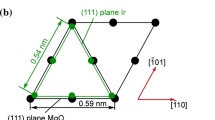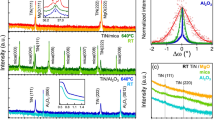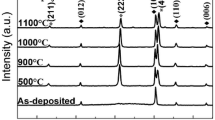Abstract
The growth and thermal stability of textured iridium thin films used as bottom electrode in electronic devices based on ferroelectric materials were investigated. The thin films were grown using the dc magnetron sputtering technique. The Ir layers directly deposited on SiO2/Si substrates present a mixed (111) and (200) orientations, while the films grown on Ti seed layers exhibit a strong preferred (111) orientation favoured by good matching with the titanium lattice. The substrate temperature during the growth of iridium/titanium stack has a significant effect on the surface morphology of the iridium layer and its thermal stability. The as-grown surface of 20-nm-thick Ir films is smooth, having a root-mean-square (rms) roughness of 0.7 nm. After thermal annealing the Ir film shows an increased surface roughness due to the formation of agglomerations. The change in the surface morphology of the Ir layer is due to titanium diffusion and its oxidation. Thicker and better crystallised iridium thin films annealed in oxygen atmosphere at 700 °C show a good thermal stability with only a slight modification of the surface morphology. Within the limits of experimental error, there is no change in the electrical resistivity before and after thermal annealing. The rms roughness has not varied significantly and the XPS investigation shows no traces of titanium oxide on iridium surface. Ir/Ti stack deposited under the optimum conditions could be successfully used as electrode in devices based on oxide thin films.










Similar content being viewed by others
References
Cross JS, Fujiki M, Sakai T, Tsukada M, Kamehara N (1999) Characterization of sol-gel PZT capacitors with SrRuO3 and Pt electrodes. Key Eng. Mat. 157–158:181–187
Wu W, Wang Y, Pang GKH, Wong KH, Choy CL (2004) Effect of lattice-misfit strain on the process-induced imprint behavior in epitaxial Pb(Zr0.52Ti0.48)O3 thin films. Appl Phys Lett 85:1583–1585
Dekkers M, Nguyen MD, Steenwelle R, te Riele PM, Blank DHA, Rijnders G (2009) Ferroelectric properties of epitaxial Pb(Zr, Ti)O3 thin films on silicon by control of crystal orientation. Appl Phys Lett 95:012902
Al-Shareef HN, Gifford KD, Rou SH, Hren PD, Auciello O, Kingon AI (1993) Electrodes for ferroelectric thin films. Integr Ferrolectr 3:321–332
Firebaugh SL, Jensen KF, Schmidt MA (1998) Investigation of High-Temperature Degradation of Platinum Thin Films with an In Situ Resistance Measurement Apparatus. J Microelectromech Syst 7:128–134
Löffler M, Vorobiev A, Zeng L, Gevorgian S, Olsson E (2012) Adhesion layer-bottom electrode interaction during BaxSr1−xTiO3 growth as a limiting factor for device performance. J Appl Phys 111:124514
Oh SH, Park C-G (2001) Nanoscale characterization of interfacial reactions in SrRuO3 thin film on Si substrate. Surf Interface Anal 31:796–798
Erdin S, Lin Y, Halley JW (2005) Self-consistent tight-binding study of low-index titanium surfaces. Phys Rev B 72:035405
Gablech I, Svatos V, Caha O, Hrabovsky M, Prasek J, Hubalek J, Sikola T (2016) Preparation of (001) preferentially oriented titanium thin films by ion-beam sputtering deposition on thermal silicon dioxide. J Mater Sci 51:3329–3336
Haftel MI, Bernstein N, Mehl MJ, Papaconstantopoulos DA (2004) Interlayer surface relaxations and energies of fcc metal surfaces by a tight-binding method. Phys Rev B 70:125419
DiBattista M, Schwank JW (1999) Determination of diffusion in polycrystalline platinum thin films. J Appl Phy 86:4902–4907
Martinez WE, Gregori G, Mates T (2010) Titanium diffusion in gold thin films. Thin Solid Films 518:2585–2591
Tanuma S, Powell CJ, Penn DR (1994) Calculations of electron inelastic mean free paths. Surf Interf Anal 21:165
Acknowledgements
This work was financially supported by the “Agence National de la Recherche” (ANR)-France and the National Authority for Scientific Research (ANCS)-Romania, under the project MAESTRO.
Author information
Authors and Affiliations
Corresponding author
Rights and permissions
About this article
Cite this article
Trupina, L., Nedelcu, L., Negrila, C. et al. Growth of highly textured iridium thin films and their stability at high temperature in oxygen atmosphere. J Mater Sci 51, 8711–8717 (2016). https://doi.org/10.1007/s10853-016-0131-1
Received:
Accepted:
Published:
Issue Date:
DOI: https://doi.org/10.1007/s10853-016-0131-1




